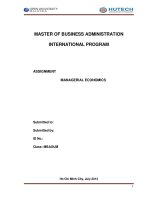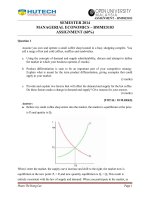Managerial economics assignment MBA
Bạn đang xem bản rút gọn của tài liệu. Xem và tải ngay bản đầy đủ của tài liệu tại đây (133.43 KB, 11 trang )
1
MASTER OF BUSINESS ADMINISTRATION
INTERNATIONAL PROGRAM
ASSIGNMENT
MANAGERIAL ECONOMICS
Submitted to:
Submitted by:
ID No.:
Class: MBAOUM
Ho Chi Minh City, July 2013
2
SEMESTER 2013
MANAGERIAL ECONOMICS – BMME5103
ASSIGNMENT (60%)
Question 1
Read the following information and answer the questions below.
Competition: the population factor
As the debate about the optimum size of the Australian population continues, one
question that should be asked is whether the relatively small population creates difficulties
in maintaining an efficient and competitive economy. And if this is the case, what is the
solution?
There are two key consequences of a small population. First, it can hinder economic
efficiency. On the demand side, Australia, with its small population, is handicapped by a
relatively low domestic demand for goods and services, which limits the amount of
production and robs companies of the opportunity to achieve the benefits of large-scale
production. On the supply side, even if demand is substantial – due to exports, for
example – the work force is relatively small. This means that in some industries, any
economy of scale is harder to achieve in Australia than it is in countries with larger
populations. Second, in some Australian industries there will be fewer competitors and
less competition that exists in the same industries in much larger economies. In many
Australian markets, only one or two large firms are needed to meet the existing demand
adequately. Their dominance may deter new market entrants. A company considering
entering a market may be deterred on finding that there is room to sell only a very small
proportion of the production necessary to achieve economies of scale.
Empirical research confirms there is a negative correlation between the size of
population and the degree to which the economy is concentrated in specific sectors.
In Australia, there certainly seems to be a high concentration in many sectors,
including manufacturing, retailing, transport, service industries and construction,
due to such factors as population size and a historically weak or non-existent merger
law. The reduced completion lowers pressure on firms to operate efficiently,
reinforcing the disadvantages of inefficiency created by small-scale production.
Having a small population can often mean inefficiency and lack of competition,
causing high prices, reduced services and less innovation. In Australia, the problem
is made worse by a widely dispersed population. We may be highly urbanized but the
3
capital cities that hug the coastline are far apart, often requiring separate production
facilities and inhibiting competition between businesses in different cities.
Are there any ways out of this problem? One answer is a larger population, but
achieving that would require many years of high population growth. Moreover, this
solution merely focuses narrowly on the demand and supply for everyday goods and
services, and ignores some of the disadvantages of a large population, including crowding,
population and the depletion of natural resources. Another way out of these problems is
through trade. If we increase exports, we can achieve access to much larger markets and
so gain the benefits of larger-scale production. A flow of imports will often stimulate the
competition that is otherwise lacking in a small economy. However, Australia’s position is
not the same as that of other countries closer to large markets. Canada and Sweden, for
example, are close to big markets and can more easily achieve these benefits (although, as
the costs of transport and communication fall, this relative disadvantage is receding).
Third, do we need to compromise competition policy? Should all anti-
competitive practices and mergers be prohibited, as in the US, or should there be some
compromise by making arrangements where the benefits of large-scale production can be
achieved, albeit at a cost to competition? The answer is that, in many cases, such a
compromise is not necessary. First, sufficient import competition may justify a single
producer in the Australian economy without compromising competition. The Australian
Competition and Consumer Commission has not opposed any mergers in the past decade
where there has been import competition. Second, in many sectors of the economy in
Australia, economies of scale count, and where import completion is weak, that a balance
may be required.
Unlike the situation in most other countries, the law in Australia permits anti-
competitive arrangements to be authorized if the applicants can demonstrate a sufficiently
large public benefit to outweigh any detriment caused by the lack of competition. An
example of this is the proposal by Qantas and Air New Zealand to coordinate their prices
and services. This seems quite anti-competitive, but the applicants argue that there are
benefits for both countries, such as the achievement of sufficient scale to develop a large
world airline. The authorization process allows for a careful, public and independent
evaluation of these claims.
Many social and economic factors require consideration in the population debate.
Questions about economies of scale and competitive outcomes are only one aspect but as
the debate continues – and it has already been going for 100 years – these will continue to
be key issues for business and government.
4
a. Explain how a small population may mean that industries cannot benefit from
economies of scale. Are there exceptions to this?
(15 marks)
b. Why might a small population mean industry has low concentration and high prices? Are
there exceptions to this?
(15 marks)
c. What are the three ways suggested in the article to improve efficiency and increase
competition?
(10 marks)
[TOTAL: 40 MARKS]
Question 2
A monopoly has the following demand and cost data as shown below
Assume fixed costs of $300.
P ($) Q (units) TVC ($)
500 0
450 1 230
400 2 440
350 3 690
300 4 990
250 5 1410
200 6 1960
150 7 2710
100 8 3710
(a) For the output and cost figures given above, calculate the average variable cost
(AVC), average total cost (ATC) and marginal cost (MC).
(6 marks)
5
(b) For the price and quantity figures given above, calculate total revenue (TR) and
marginal revenue (MR).
(6 marks)
(c) Based on the figures above, determine the short run profit maximizing (loss
minimizing) output and total profit or loss for this monopoly.
(6 marks)
(d) Suppose the government were to impose a price ceiling at the allocative efficient
price. What is the value of this price and resulting level of output?
(6 marks)
(e) Would the monopolist remain in business in the long run if the price ceiling remained
in place? Explain your answer.
(6 marks)
[TOTAL: 30 MARKS]
Question 3
Suppose you have the following game:
Firm A
Firm B
Low price
High price
Low price
10,20
20,0
High price
80,100
100,80
a. Find out Nash equilibrium, if any.
(6 marks)
b. Explain the concept of mutual interdependence.
(6 marks)
c. Assuming no collusion, what is the likely outcome of the game?
(6 marks)
d. Given your answer to (c), explain why collusion is mutually profitable.
6
(6 marks)
e. Why might there be a temptation to cheat on the collusive agreement?
(6 marks)
[TOTAL: 30 MARKS]
ANSWER
Question 1:
a. A small population may mean that industries cannot benefit from economies of scale.
There are some evidences for this issue:
- A small population creates difficulties in maintaining an efficient and competitive
economy.
- It can hinder economic efficiency. For example: with a small population, Australia
is handicapped by a relatively low domestic demand for goods and services, which
limits the amount of production and robs companies of the opportunity to achieve
the benefits of large-scale production.
- There will be fewer competitors and less competition that exists in the same
industries in much larger economies. One or two large firms are needed to meet the
existing demand adequately.
There is exception due to economies of scale. A company considering entering a
market may be deterred on finding that there is room to sell only a very small proportion
of the production necessary to achieve economies of scale.
b. A small population mean industry has low concentration and high prices because there
is a relationship between the size of population and the degree to which the economy
is concentrated in specific sector. Having small population lead to less efficient and
lack of competition, causing high price, reduced services and less innovation as well.
In this case, there will be no exceptions.
7
c. Three ways to improve efficiency and increase competition suggested from the article
including:
- Firstly, a large population with high population growth, but also ignore some
disadvantages of large population such as crowding, population and the depletion
of nature resources.
- Secondly is by through trade. Once increase exports, we can achieve access to
much larger markets and so gain the benefits of larger-scale production.
- Lastly, we do need to compromise competition policy. In some cases, such
compromise is not necessary. For example, in Australia, sufficient import
competition may justify a single producer without compromising completion. But
in many sectors of the economy in Australia the balance may be required due to
economies of scale count and where import completion is weak. On the other side,
anti-competition brings benefits for both countries in corporation.
Question 2:
(a), (b)
Whereas:
AVC =
TC = TVC + FC
ATC =
MC =
∆
∆
TR = P x Q
MR =
∆
∆
8
Profits/ Loss = TR - TC
P ($)
Q
(units)
TVC ($)
FC
($)
AVC
($)
TC
($)
ATC
($)
MC
($)
TR
($)
MR
($)
Profits/Loss
($)
500
0
300
300
0
-300
450
1
230
300
230
530
530
230
450
450
-80
400
2
440
300
220
740
370
210
800
350
60
350
3
690
300
230
990
330
250
1050
250
60
300
4
990
300
247.5
1290
322.5
300
1200
150
-90
250
5
1410
300
282
1710
342
420
1250
50
-460
200
6
1960
300
326.67
2260
376.67
550
1200
-50
-1060
150
7
2710
300
387.14
3010
430
750
1050
-150
-1960
100
8
3710
300
463.75
4010
501.25
1000
800
-250
-3210
(c) Profits maximization where MC cuts MR from below (MR = MC). Based on the table
above, the short run profits maximization is determined at MR = MC = 250$, with P = 350$
and at level of output is Q = 3 units, Profits = 60$.
(d) Suppose the government were to impose a price ceiling at the allocative efficient price.
Then in monopoly, allocative efficiency achieve at Price equal to Marginal Costs (P = MC).
In this case, P = MC = 300$ and the level of output is at Q = 4 units, Profits/ Loss = -90$.
(e) If the price ceiling remained in place, the monopolist would remain in long-run business
due to loss will be recovered in short run, monopolist may get loss because of weak demand
or high cost, but when keeping the price ceiling, MC is decreasing allow monopolist to
charge a fixed fee so that the loss will be recovered. In the long run, monopolist remain in
business if P ≥ ATC. In this case, in the long run, company should produce at Q = 3 units
with P = 350$ which is smaller than ATC = 330$. If the price ceiling remain in place, in the
long run, the monopolist will stop their business if P < ATC.
9
Question 3:
a. Nash equilibrium:
Firm A
Firm B
Low Price
High Price
Low Price
10,20
20,0
High Price
80,100
100,80
- When Firm A offers Low price, Firm B will get whether 20 or 0, then 20 > 0.
- When Firm A offers High price, Firm B will get whether 100 or 80, then 100 > 80.
- When Firm B offers Low price, Firm A will get whether 10 or 80, then 80 > 10.
- When Firm B offers High price, Firm A will get whether 20 or 100, then 100 > 20.
Therefore we find out the Nash equilibrium is at (80,100).
b. Explain the concept of mutual interdependent:
In the market, each firm has its own power and recognizes that it must take into
account the behavior of its competitors when it makes decisions. Firm has to
consider the actions and the possible reaction of rivals. On one hand, each firm is in
a position to influence the price, output and profits of other ones in the market. On
the other hand, it cannot fail to take into account the reactions of others to its price
and output policies. Therefore, every firm should consider competitors carefully
before making any decision. Successful decision making depends on the prediction
of the rival firms’ reactions to the policy decisions of the firm.
c. If there is no collusion, each firm should use their Dominant strategy (or Maximin
strategy, if any) to get the most benefits of them.
Firm A
Firm B
Low Price
High Price
Low Price
10,20
20,0
High Price
80,100
100,80
10
Case 1: Dominant Strategy:
- If Firm A chooses Low Price and Firm B chooses Low price:
We can see that Low Price is the dominant strategy for firm B, because any strategy
firm A chooses, firm B still has the higher payoff at Low Price (20 > 0 and 100 >
80), so Firm B will offer a Low Price. Firm A can increase their payoff from 10 to
80 by choosing High Price rather than Low Price.
- If Firm A chooses High Price and Firm B chooses High Price.
We can see that High Price is the dominant strategy for firm A, because any
strategy firm B choose, firm A still has the higher payoff at High Price (80 > 10 and
100 > 20), for Firm A will not change their decision in High Price.
Firm B can increase their payoff from 80 to 100 by choosing Low Price rather than
High Price.
In summarize, there is Dominant Strategy for both of Firms which is Firm A will
offer High Price and Firm B will offer Low Price.
Case 2: Maximin Strategy:
Firm A:
- If they choose a Low Price option, they will receive either 10 or 20 profit,
depending on the option chosen by Firm B, so the worst Firm A will make 10
profits.
- If they choose a High Price option, they will receive either 80 or 100 profits, so the
worst Firm A will make 80 profits.
Comparing between 10 and 80, the maximum (the best) of two minimum is 80.
Therefore, Firm A will offer High Price Strategy.
Firm B:
- If they choose a Low Price option, they will receive either 20 or 100 profit,
depending on the option chosen by Firm A, so the worst Firm B will make 20
profits.
- If they choose a High Price option, they will receive either 0 or 80, the worst is 0.
11
Comparing between 0 and 20, the maximum (the best) of two minimum is 20.
Therefore Firm B will offer Low Price Strategy.
Conclusion, if there is no collusion, the outcome of the game is that firm A will offer
High Price and Firm B will offer Low Price Strategy.
d. Collusion is mutually profitable: From results in (c), we can see that if there is no
collusion then each of firm has its own strategy to maximine profits or minimine the
lost.
e. There may be a temptation to cheat on the collusive agreement: Because all of
cheating activities derive from benefits. Who can cheat other then can get higher
profits. However in this game, there may be no cheating action due to each of them
already get the best profits compare to the rest.









